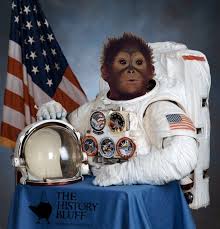Gordo the Space Monkey
Old Reliable

Gordo was one of the first monkeys to make it into space as part of NASA's space program. Eight monkeys had flown on NASA missions before him, five of whom went by the name of Albert.
Gordo's historic flight took place on December 13, 1958 when he took off from Cape Canaveral for a 15 minute flight into space. Even though he was weightless for over 8 minutes the on-board instruments indicated that Gordo enjoyed his journey into space. Scientists monitoring the flight were pleased to note that the only slight side effect Gordo suffered from the entry into space was a modest slowing of his pulse.
The Mission
The rocket carrying Gordo into space would take off from the Atlantic Missile Range at Cape Canaveral, travel further than any monkey had ever travelled before - over 1,500 miles - and reach a height of 310 miles (500 km) before returning to Earth and landing in the South Atlantic, 1,302 nautical miles south of Cape Canaveral.
"We all heard the rumors that they want to send a monkey up first. Well, none of us wants to think that they're gonna send a monkey up to do a man's work ... what they're trying to do to us is send a man up to do a monkey's work."
Deke Slayton, Mercury Seven Astronaut
The Jupiter AM-13
The Jupiter IRBM (Intermediate Range Ballistic Missile) was originally developed by the US Army as a long-range successor to its PGM-11 Redstone missile, but was eventually taken over and deployed by the USAF for political reasons. It was also the only one of the United States' early stategic ballistic missiles with some mobility.
However, in November 1958, the Air Force decided Jupiter would be launched from fixed emplacements. Army General Maxwell Taylor argued this was done deliberately, noting that:
...a mobile missile needs Army-type troops to move, emplace, protect and fire it... a decision to organize mobile ballistic missile units would in logic have led to transferring the operational use of the weapon back to the Army – where it should have been all the time.
The Juno II launch vehicle was derived from the Jupiter IRBM and its specifications are representative of the type of missile involved in the launch.
| Parameter | First Stage | Second Stage | Third Stage | Fourth Stage |
|---|---|---|---|---|
| Gross Mass | 54,431 kg | 462 kg | 126 kg | 42 kg |
| Empty Mass | 5,443 kg | 231 kg | 63 kg | 21 kg |
| Thrust | 667 kN | 73 kN | 20 kN | 7 kN |
| Burn time | 182 s | 6 s | 6 s | 6 s |
| Length | 18.28 m | 1.0 m | 1.0 m | 1.0 m |
| Diameter | 2.67 m | 1.0 m | 0.50 m | 0.30 m |
| Propellant | LOX/RP-1 | Solid Fuel | Solid Fuel | Solid Fuel |
The Jupiter Squadron
Jupiter squadrons consisted of 15 missiles and approximately 500 military personnel with five "flights" of three missiles each, manned by five officers and 10 NCOs. To reduce vulnerability, the flights were located approximately 30 miles apart, with the triple launcher emplacements separated by a distance of several hundred miles.
The following ground equipment was required for each launch:
- Two generator trucks
- One power distribution truck
- Precision optical instruments
- One hydraulic and pneumetic truck
- One liquid oxygen truck
- One fuel truck
- Missile trailers
Jupiter missiles were deployed to the following locations:
- United States
- Redstone Arsenal, Huntsville, Alabama
- White Sands Missile Range, New Mexico
- Italy
- Gioia del Colle Air Base
- Acquiviva delle Fonti
- Turkey
- Cigli Air Base
The Journey
Gordo wore a specially customised space suit custom made for a monkey about one foot tall. The space suit was fitted with instruments, including temperature meters and microphones which recorded his historic suborbital journey, considered one of the outstanding achievements of space research.
References
- Remembering 'Gordo'
- BC - Monkey Lost After Space Flight
- Gordo and Laika - Space Pioneers